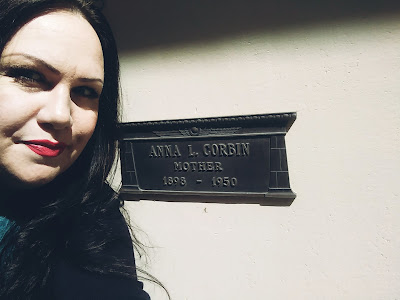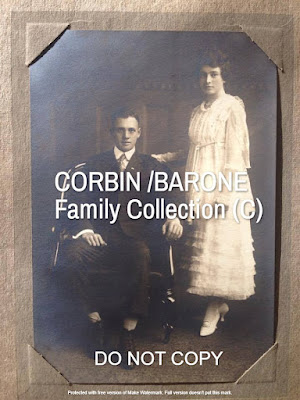 |
| At Anna's final resting place (East Lawn Cemetery) |
I have been researching the life, and death, of Anna Corbin for nearly 15 years now. What started out as a dream to research and share the true story of what happened to her so many years ago, when she was brutally murdered in the basement at the castle, also turned into a career long desire to share Anna's life story.
Over 11+ years ago, I became friends with Anna's great-granddaughter Lily, who has offered me a plethora of information to use in my research and writing about Anna. In my research which has spanned over 15 years, I have also been able to provide the family with additional information they were not aware of as well.
One of the facts that had eluded me for many years until just recently was Anna's home address. I always knew she lived in a house in Ione, not at the Castle, as so many people have tried to claim. The newspapers reported at the time she died said very clearly that she lived in a house in town. One newspaper stated that it was a 5 room house on Marquette Street. Well, there is no "Marquette Street" in Ione. There is a Market Street, and there is a Marlette, but which one was it? The library at the time had no directory index for the time period Anna lived in Ione, which left me stumped for a very long time.
When I published my book "Behind the Walls," back in 2012, I had to leave that bit of definitive information up in the air, so I mentioned the house was located either on Market or Marlette, but I was never certain the address.
Well, by way of Robert Corbin's Will Records I was able to find the exact location.
The house itself sits set back on the corner of Market and Amador, and is in fact one block from Marlette, too. So it is easy to see how the journalist back in 1950 got confused. So today, I am posting this blog to state as a fact that Anna Corbin DID NOT live at Preston Castle at any point in time, just as I have always stated, and that she in fact lived in her home, just as the newspapers in 1950 had stated all along.
 |
| Photo Courtesy of Lance Pryor |
 |
| Photo: Roland Boulware |
 |
| Photo: Roland Boulware |
 |
| Photo: Roland Boulware |
To find this home was like solving puzzle that had been out of my reach for so long. Although I had pieced together Anna's life and death over a span of 15 years, I have finally found the missing piece, her home! Originally listed as 204 S. Amador, but is now technically 206 S. Amador, the home is located on the corner of Amador and Market Streets in Ione, California.
Originally owned by Martin Van Buren French and his wife, California "Calla" French, the home was possibly built sometime around 1895, according to the current owner's research. The county records state the home was built in 1880, but I believe that was when the land was mapped out as an individual property, not necessarily having a house on the land at that point.
We do see the French's living in Ione by way of the 1880 Census, but the specific location is not mentioned. Martin passed away in 1885, which is why on the records I found, only Calla is mentioned as Mrs. California French. According to the current owner's, the Sanborn maps do not show a structure on this site until at least 1898, meaning the house was built sometime between 1893-1898 based on the Sanborn maps. At the age of 72, Calla French then sold the property to Charles Kirk in 1922.
Kirk also owned the adjacent lot on the corner of Marlette and Amador Street, which is literally next door. Robert and Anna Corbin purchased the property sometime around 1935, upon arriving to Ione to work at the Preston School of Industry. After Anna's passing, her daughter Avis Barone sold the home to Russell Doss, and since then the home has had 8 more owners (including Mr. Doss).
During my research to locate the address of Anna's home, I also learned that Anna used to drive a 1941 Pontiac (similar to this photo) to and from work, and that she even had 2 horses on her property on the hillside. I can only imagine the wonderful times she spent there in that beautiful home.
So, last Saturday I happened to be on my way up to Jackson and so we stopped by Anna's house to take a look at it in person, and to take a photo outside. I saw the owner was outside working on the picket fence and my fiance' told me to go up and start a conversation with him. I am not a big social person, so that isn't easy for me to do, but I did it anyway. And I am sure glad that I did.
After bringing up the topic of Anna & Robert Corbin having had owned the house long ago, he confirmed that he knew the story and that he had just recently read an article online about her life, and had even printed it. After talking to him about it, I confirmed to him that the article was written by yours truly. Both the owner and his wife were the kindest, most genuine people and they so generously invited us into their home for a grand tour.
The first thing that I noticed upon entering the house was the lovely kitchen with towering cabinets and a window just above the kitchen sink. I stopped for a second and imagined Anna standing there, looking out that very window as she washed dishes and wondered how many times she must have stood there, thinking, wondering, maybe even deciding what she planned to make for dinner. :-)
I also started imagining the scenario of an old Victrola playing "Moonlight Serenade" by Glenn Miller, while Anna and her husband Bob stood there as she washed the dishes and he dried them (Sort of like the scene in movie, "Catch Me If You Can.") Looking out the window of the front of the house, I could imagine Anna sitting on the porch, watching the sunset. The memories she shared with her children, her husband and their friends, too. I thought of her route to work, or that she may have walked down the hill to the Methodist Church for Sunday services with her hat and gloves, just the way my grandmother did back in that time period. There are so many things now I can really ponder now that I have a visual spot to imagine her at.
 |
| COPYRIGHTED - DO NOT SHARE |
I also imagined the lovely 25th Silver Wedding Anniversary she celebrated with her husband in 1943, at that very home surrounded by her loved ones. How beautiful she must have looked, donning her wedding gown, while Robert Corbin past their marriage certificate around for all their guests to sign. The music playing, the dancing and the cutting of their anniversary cake, all must have been wonderful memories shared behind the walls of that beautiful home.
The photo posted is a copy of Anna and Robert's wedding photo taken in 1918, and is property of the Corbin/Barone family. Anna's great-granddaughter gave me exclusive permission to share this photo, but I watermarked it for safety so that no one else can share this photo, as it is not anyone's right to share. (DO NOT COPY OR SHARE)
The owners verified that there has been some work done to the property since they purchased it some 30 years ago, but they have restored it back to the way it once was with some modifications. The backyard has seen some changes over the years, and now it is like a beautiful garden. There once was Wisteria growing in the back, which eventually overcrowded the carport area and it had to be removed and the carport demolished. There also were lots of cherry plum trees all over, which have been removed as well. An old shed dating back to the 1940's was out back but was also razed, to remodel the backyard into a gorgeous space with plants, a pool and lots of shade.
Inside, there is still crown moulding around the doorways and the ceiling, original hardwood flooring, etc. The walls are decorated in a gorgeous wallpaper, although the owners confirmed it is not the original wallpaper. The kitchen is the same, although the room has been extended a bit. I can honestly say this property is a gorgeous oasis of peace and tranquility, and the owners have also let me know, it is NOT HAUNTED.
It was a dream come true being able to visit Anna's home, to see where she lived, and walk the floors that she walked. Although there are some changes, the house still looks the same on the outside.
So, today I decided to share this blog with the hopes that if you really want to know Anna's story, you need to get to know Anna. Not only by my sharing the information about her house, but also by my sharing of information about her as a person. So, just who was Anna Corbin?
Well, there is a lot more to her than just the fact she was a head housekeeper at Preston who was murdered! She was a very well educated, spirited, generous, kind and loving human being. She was a good Christian woman, a loving mother and a loyal wife. She was a very hard working person, who not only worked full time at Preston, but she devoted a lot of her time to her Church as well.
I have written so many blogs, chapters in books and even dedicated an entire hour long podcast to Anna's story, just to make sure her story is told correctly, and with respect. There has been so much misinformation for so many years spread about her death, even claiming she lived at Preston.
From people giving tours there, to Ghost Adventures claiming she lived in the upstairs apartment area, down to the film "Apparition" which made the character "Anna" (which was based on Anna Corbin) also living in the Administration building. All factually incorrect, yet, continuously perpetuated which misleads the public who for the most part do not bother to verify everything they read, see and hear.
By sharing with you Anna's life, I can make her a real person to you, not just a ghost story. In my mind, I see her there, in that house, happy. Not a lonely ghost wandering the empty halls of an old abandoned school. And no, I don't believe she haunts the house, I just mean the memory of her there. Again, the owner's stated the home is NOT HAUNTED. --
Also, being that this is a private residence, please show respect and DO NOT DISTURB the owners if you happen to drive by to look at the house.
If you would like to know more about the true history of Anna Corbin please follow the links below to my podcast where you can hear all about it, or you can read the blog below.
PODCAST: Stories of the Forgotten - Preston Castle History: Anna Corbin's Story Revealed
BLOG: https://dreamingcasuallypoetry.blogspot.com/2019/11/the-life-and-death-of-anna-corbin.html
Thank you for visiting Preston Castle History!
- J'aime Rubio (Copyright 2022) www.jaimerubiowriter.com
-- Thank you to the Pryors for the lovely tour and to allow me permission to write about your home. Thank you to Roland Boulware for the photography of the outside of the home.














